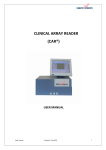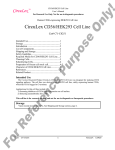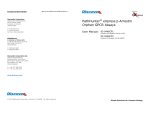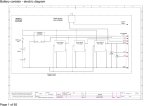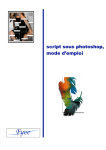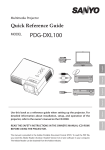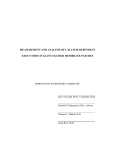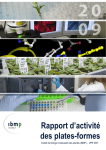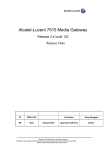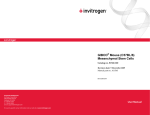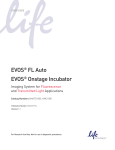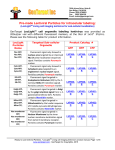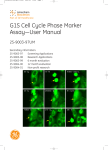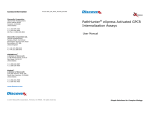Download EGFP-2x FYVE Assay - GE Healthcare Life Sciences
Transcript
GE Healthcare EGFP-2x FYVE Assay Product User Manual Codes: 25-8010-21 25-8010-22 25-8010-23 25-8010-24 Page finder 1. Introduction 1.1. FYVE domains as cellular sensors of phosphoinositol 3-phosphate 1.2. The FYVE finger 1.3. EGFP-2x FYVE assay 3 2. Licensing considerations 2.1. Right to use 2.2. Legal 6 6 7 5.4. Assay characterization 5.4.1. Transloction index 5.4.2. Summary of quantitive assay parameters 5.4.3. Seeding density 5.4.4. Wortmannin dose response 5.4.5. Time course 5.4.6. Sensitivity of assay to DMSO, Ethanol and Methanol 5.4.7. Effect of different assay media 5.4.8. Effect of serum starvation 5.4.9. Effect of using the nuclear marker DRAQ5 on the Translocation 5.4.10. Results obtained on the IN Cell Analyzer 1000 3 3 5 3. Product contents 8 3.1. Component summary 8 3.2. U-2 OS derived cell line expressing EGFP-2x FYVE fusion protein - NIF2021 8 3.2.1. U-2 OS derived parental cell line 8 3.2.2. U-2 OS derived EGFP-2x FYVE expressing cell line 8 3.3. EGFP-2x FYVE expression vector – NIF2022 8 3.4. Materials and equipment required 9 3.5. IN Cell Analysis System 9 3.5.1. IN Cell Analyzer 3000 9 3.5.2. Granularity Analysis Module 9 3.5.3. IN Cell Analyzer 1000 9 3.6. EGFP-2x FYVE translocation assay on epifluorescence microscopes 10 3.7. Software requirements 10 4. Safety warnings, handling and precautions 4.1. Safety warnings 4.2. Storage 4.3. Handling 4.3.1. Vector 4.3.2. Cells 11 11 12 12 12 12 5. Cell assay design 5.1. Culture and maintenance of U-2 OS derived EGFP-2x FYVE expressing cell line 5.1.1. Tissue culture media and reagents required 5.1.2. Reagent preparation 5.1.3. Cell thawing procedure 5.1.4. Cell sub-culturing procedure 5.1.5. Cell seeding procedure 5.1.6. Cell freezing procedure 5.1.7. Growth characteristics 5.2. Assay set up 5.2.1. Live cell EGFP-2x FYVE assay using the IN Cell Analyzer 3000 5.2.2. Microplate set up for 96 well format assays 5.2.3. Schematic agonist assay protocol 5.2.4. Assay protocol (96 well format) 5.3. Results 5.3.1. Calculating Z’-factor 5.3.2. Example results 13 13 13 13 14 14 15 15 15 16 18 18 18 19 19 20 20 21 21 22 22 6. Vector use details 6.1. General guidelines for vector use 6.2. Transient transfection with pCORON1000 EGFP-2x FYVE 6.3. Stable cell line generation with pCORON1000 EGFP-2x FYVE 23 23 7. Quality control 7.1. EGFP-2x FYVE cell line 7.2. EGFP-2x FYVE expression vector 24 24 24 8. Troubleshooting guide 25 9. References 26 10. Related products 27 11. Appendices 11.1. Appendix A: Restriction map of pCORON1000 EGFP-2x FYVE 28 23 23 28 Front cover Top image: U-2 OS derived EGFP-2x FYVE expressing cell line before the addition of Wortmannin. Hoechst nuclear stain is also shown. Imaged on the IN Cell Analyzer 3000. 16 16 16 16 17 17 17 Bottom image: U-2 OS derived EGFP-2x FYVE expressing cell imaged 30 minutes. after treatment with 100 nM Wortmannin. Bioimage is a Danish Biotech company specializing in developing drug candidates that exert their activity through modulation of protein translocation. For more information, visit their Web site at www.bioimage.dk 25-8010-21UM Pagefinder, Rev B, 2006 2 1. Introduction 1.1. FYVE domains as cellular sensors of phosphoinositol 3-phosphate The FYVE-finger is a cysteine-rich domain of approximately 60-80 amino acids that binds specifically to the inositol head group of phosphatidylinositol 3-phosphate (PI(3)P) (For review, see 1). PI(3)P has been implicated as an important mediator of vesicular transport, and is abundant in early endosome membranes and internal membrane structures of late multivesicular endosomes (MVBs) (2). The majority of cellular PI(3)P is thought to be generated by the constitutive action of a class III phosphatidylinositol 3-kinases (PI3-kinase) (3). PI3-kinases phosphorylate phosphatidylinositol at the 3 position of the inositol ring to produce PI(3)P, and in so doing help to maintain PI(3)P levels in the membrane. Inhibitors of PI3-kinase activity induce a decrease in PI(3)P levels observed in endosomal/MVB membranes (2). A GFP reporter molecule based on tandem FYVE domains from the human homologue of hepatocyte growth factor regulated tyrosine kinase substrate (Hrs) has been shown in live cells to localize to PI(3)P on early endosome membranes in a PI3-kinase-dependent fashion, and may be exploited as an endosomal marker and reporter for the presence of cellular PI(3)P (2,4). Since the majority of PI(3)P is maintained through class III PI3-kinase activity, FYVE-domain reporter proteins may also potentially be used in conjunction with other phosophoinositide reporters as class III-specific PI3-kinase sensors, although the class-specificity of the EGFP2X FYVE reporter remains to be confirmed. PI3-kinases play critical roles in the regulation of many cellular processes, including cell proliferation, survival, motility, and metabolism, and are therefore of great interest as therapeutic targets (for review see 5). Three main classes of PI3-kinase have been identified to date, based on structure, binding partners, mode of activation and in vitro substrate specificity. Class I PI3-kinases are activated by extra-cellular signalling through receptor tyrosine kinases and some GPCRs. The phoshoinositide products of class I PI3-kinases are often binding substrates for pleckstrin homology (PH) domain-containing proteins such as Akt1, PDK1 and Tec kinases. Class I PI3-kinases have been implicated in oncogenesis and tumor progression, and have therefore recently attracted attention as potential targets for cancer therapy. Class II PI3-kinases are the least understood class, but their subcellular localization has implicated them in vesicle formation or sorting events. Class III PI3-kinases, which are homologues of the yeast vacuolar sorting protein vps27, are believed to be important for intracellular membrane trafficking, but have also been shown to be involved in regulation of key extracellular signaling pathways, such as the TGFß pathway, that signal through the endosome. Class III PI3-kinase pathways are typically mediated by FYVEdomain-containing proteins, including EEA1, p235, Hrs, SARA, and Fgd1. Because PI3-kinases are involved in diverse critical signalling and trafficking pathways, inhibitors that act on multiple classes are likely to have unacceptably high degrees of toxicity and non-specific effects (5). Most PI3-kinase inhibitors identified to date act to some extent on more than one PI3-kinase class in vitro. PI3-kinase sensors such as the EGFP-2X FYVE domain may be useful in the discovery and development of more selective therapeutic inhibitors. 1.2. The FYVE finger The FYVE domain was named after four proteins in which it was originally found, namely Fab1, YOTB, Vac1p and EEA1. FYVE domains have eight conserved cysteine residues that co-ordinate two Zn2+ ions in a specific conformation. The third cysteine residue lies within a highly conserved basic motif R(R/K)HHCRxCG motif that mediates binding of the inositol head group of PI(3)P (6). The biochemical function of the FYVE domain was uncovered when it was discovered that several FYVE-finger proteins specifically bind PI(3)P. The highly conserved nature of FYVE 25-8010-21UM Chapter 1, Rev B, 2006 3 fingers strongly suggests that they all bind to PI(3)P or a similar ligand. High affinity binding of FYVE domains to PI(3)P is thought to depend not only on the inositol head group itself, but also on presence of the intact lipid within a membranous structure (7,8). FYVE finger proteins can be subdivided into distinct groups comprising proteins with diverse structures and functions. While some are involved in membrane tethering, others contain kinase, phosphatase and GDP/GTP exchange factor domains. The different groups of FYVE finger proteins participate in distinct cellular processes, including vesicle transport, cytoskeletal regulation, and signal transduction (6). The endosomal pathway is believed to be an important route for the transduction of extracellular stimuli into intracellular responses (Fig 1.1). In mammalian cells, proteins can be endocytosed via clathrin-coated pits, the clathrin independent pathway or caveolae within the membrane. All of these internalization pathways lead to the appearance of the trafficked protein in early endosomes. From early endosomes, the protein may be recycled back to the plasma membrane, sorted to the late recycling compartment or targeted to late endosomes (the pre-lysosomal pathway) where it is destined for degradation (9). Many FYVE-finger proteins have been implicated in membrane trafficking along endosomal/lysosomal pathways, including EEA1 (10), Hrs (11,12), and the yeast proteins Vac1p, Vps27p and Fab1p (13,14 ). F EG TfR EGF R Tf 2Fe++ Tf Extracellular Tf 2Fe++ 2Fe++ Tf Cytoplasm TfR R Tf Clathrin F EG EG F 2F e+ + Recycling endosome TfR EG FR FR EG R Tf 2F Tf Rab5 C2H2 b5 EEA1 R Ra P PI3P FYVE Ub F EG R F EG Orange = Rab5 binding domain TGN Pink = FYVE PI3P binding domain (EEA1, HRS) Blue = Ubiquitin interacting domain TGN Red = Clathrin binding domain Golgi Lysosome Fig 1.1. The role of FYVE-finger proteins in vesicle transport (provided with permission from BioCarta, www.biocarta.com). 25-8010-21UM EG F PI3 HR Ub Primary endosome Tf R F EG S HRS + Tf HRS EGF R EGF Ub Ub EG F EG F EGF R S HR PI3P F EG P Ub P HRS PI3 S HR PI3 2Fe++ PI3P PI 3P Early endosome e+ + Late endosome Chapter 1, Rev B, 2006 4 Although membrane trafficking is the most well-characterized role proposed for FYVE-finger proteins, some FYVE domain-containing proteins appear to have alternative functions. Several lines of evidence suggest that the FYVE domain may play a role in localizing signalling components to particular intracellular sites. For example, SARA (Smad anchor for receptor activation) contains a FYVE-domain that plays a critical role in transforming growth factor ß (TGFß)-induced signal transduction. SARA is believed to mediate recruitment of Smad 2 and Smad 3 to intracellular membranes (most likely endosomes) containing internalized TGFß receptor (15). The activated receptor kinase facilitates phosphorylation-dependent interaction of either Smad2 or Smad 3 proteins with Smad 4. The resulting complex then translocates to the nucleus where it activates transcription of target genes. Hrs has also been implicated in signal transduction due to observations that it undergoes agonist-dependent phosphorylation (12,16) and associates with signal transducing adaptor molecule (STAM), a mediator of cytokine-induced signal transduction (17). The FYVE domain-containing protein Fgd1, the transforming gene product of the faciogenital displasia gene, has putative GEF activity and plays a role in Cdc42-mediated signalling to the actin cytoskeleton. 1.3. EGFP-2x FYVE assay An assay has been developed using Redistribution™ technology to quantify the intracellular localization and translocation of an EGFP-2X FYVE fusion protein in stably transfected mammalian cell lines. The EGFP-2X FYVE fusion protein used in this assay consists of the FYVE finger from the human homologue of the hepatocyte growth factor-regulated tyrosine kinase substrate, Hrs, duplicated in tandem. The 2x FYVE Redistribution™ assay monitors redistribution of EGFP-2X FYVE from its initial location bound to PI(3)P in early endosomes, to the cytoplasm, in cells challenged with test compounds. This assay is optimized for image acquisition and analysis on the IN Cell Analyzer 3000 and IN Cell Analyzer 1000 using the Granularity Analysis Module, although the assay can also be imaged on other systems. The Granularity Analysis Module measures the degree of EGFP-2x FYVE localization on early endosomes by identifying granular fluorescence, defined as focal regions within the cell having a defined intensity difference from their background. On the addition of PI3K inhibitors, such as Wortmannin, which prevent the synthesis of PI(3)P, EGFP-2x FYVE redistributes to the cytoplasm (Fig 1.2). Using this assay format, Wortmannin has a typical EC50 value of 1.9 nM. Fig 1.2. Wortmannin induced redistribution of EGFP-2X FYVE from the early endosomal membranes to the cytoplasm. PI3K inhibitor, 30 minutes. Treated cell: EGFP - 2x FYVE is redistributed to the cytoplasm. Un treated cell: EGFP - 2x FYVE is concentrated in endosomes. 25-8010-21UM Chapter 1, Rev B, 2006 5 2. Licensing considerations 2.1. Right to use Use of this assay is limited as stated in the terms and conditions of sale. These vary in accordance with the product code purchased. Description Product Code EGFP-2x FYVE Assay, Screening applications EGFP-2x FYVE Assay, Research applications EGFP-2x FYVE Assay, 6 month assay evaluation EGFP-2x FYVE Assay, 12 month assay evaluation 25-8010-21 25-8010-22 25-8010-23 25-8010-24 This assay was developed in collaboration with BioImage A/S and is sold under license from: BioImage A/S under patents US 6172188, US 5958713, US6518021, EP 851874, EP 0815257,EP 0986753 and other pending and foreign patent applications; and Invitrogen IP Holdings Inc (formerly Aurora Biosciences Corporation) under US patents: US 5625048, 5777079, 5804387, 5968738, 5994077, 6054321, 6066476, 6077707, 6090919, 6124128, 6319969, 6403374 European Patent 1104769, 0804457 and Japanese patent JP 3283523 and other pending and foreign patent applications; and Columbia University. This product is also sold under license from Columbia University under US patent numbers 5491084 and 6146826. Rights to use this product, as configured, are limited to internal use for screening, development and discovery of therapeutic products; NOT FOR DIAGNOSTIC USE OR THERAPEUTIC USE IN HUMANS OR ANIMALS. No other rights are conveyed; and University of Florida Research Foundation under patents US 5968750, 5874304, 5795737, 6020192 and other pending and foreign patent applications; and Iowa Research Foundation. The CMV promoter is covered under US patents 5168062 and 5385839 and its use is permitted for research purposes only. Any other use of the CMV promoter requires a license from the University of Iowa Research Foundation 214 Technology Innovation Center Iowa City IA52242 USA; and Cedars Sinai Medical Centre. For the FYVE domain under US patent 6376174B1 and other pending and foreign patent applications. The exact terms of use for the product as configured are specified in the license accompanying the product, but are limited to internal use for screening, development and discovery of therapeutic products. No rights other than those expressly granted are conveyed. 25-8010-21UM Chapter 2, Rev B, 2006 6 2.2. Legal GE and GE monogram are trademarks of General Electric Company. Cy is a trademark of GE Healthcare companies. BioImage and Redistribution are trademarks of BioImage A/S Biocarta is a trademark of Biocarta Inc FuGENE is a trademark of Fugent, LLC Microsoft is a trademark of Microsoft Corporation Hoechst is a trademark of Aventis Geneticin is a registered trademark of Life Technologies Inc DRAQ5 is a trademark of Biostatus Limited © 2006 General Electric Company – All rights reserved. GE Healthcare reserves the right, subject to any regulatory and contractual approval, if required, to make changes in specification and features shown herein, or discontinue the product described at any time without notice or obligation. Contact your GE Healthcare representative for the most current information and a copy of the terms and conditions http//www.gehealthcare.com/lifesciences GE Healthcare UK Limited Amersham Place Little Chalfont Buckinghamshire HP7 9NA UK 25-8010-21UM Chapter 2, Rev B, 2006 7 3. Product contents 3.1. Component summary • U-2 OS derived cells expressing the EGFP-2x FYVE fusion protein (two vials, each containing 1 ml and 1 x 106 cells) - NIF2021 • pCORON1000 EGFP-2x FYVE expression vector (one vial containing 10 μg DNA, at a concentration of 250 μg/ml, supplied in TE buffer: 10 mM Tris, 1 mM EDTA pH 8.0) - NIF2022 • User manual 3.2. U-2 OS derived cell line expressing EGFP2x FYVE fusion protein - NIF2021 3.2.1. U-2 OS derived parental cell line The parental cell line U-2 OS (ATCC HTB-96) was derived from a moderately differentiated sarcoma of the tibia of a 15 year old girl (18). The U-2 OS cell line is choromosomally highly alerted, with chromosome counts in the hypertriploid range, and expresses the insulin-like growth factor I and II receptors. 3.2.2. U-2 OS derived EGFP-2x FYVE expressing cell line U-2 OS cells were transfected with the pCORON1000 EGFP-2x FYVE vector (supplied) using the FuGENE 6 transfection method according to the manufacturer’s instructions. A stable clone expressing the recombinant fusion protein was selected using 500 μg/ml Geneticin for approximately two weeks. The isolated clone was grown for 4 passages before freezing. The cells tested negative for mycoplasma, bacterial and yeast contamination (testing details are available upon request). 3.3. EGFP-2x FYVE expression vector NIF2022 The 6.7 kb plasmid, pCORON1000 EGFP-2x FYVE, contains a bacterial ampicillin resistance gene and a mammalian neomycin resistance gene (see Fig 3.1.) The sequence of the construct is available on a CD, upon request. Please e-mail [email protected] A detailed restriction map is shown in chapter 11, appendix A. Fig 3.1. Vector map of the supplied EGFP-2x FYVE expression vector C MV enhanc er C MV promoter C himeric intron A mpic illin res is tanc e gene pCOR ON 1 0 0 0 - E GFP - 2 x FY V E E G F P -2xF Y V E 6669 bp M luI (1849) B amH I (4583) B amH I (210 1) S ynthetic poly A SalI (2341) S V 40 late polyA Neomyc in res is tanc e gene f1 ori S V 40 enhanc er/early promoter 25-8010-21UM Chapter 3, Rev B, 2006 8 3.4. Materials and equipment required The following materials and equipment are required, but not provided. • Microplates. For analysis using the IN Cell Analyzer 3000, Packard Black 96 Well ViewPlates (Packard Cat # 6005182) should be used. For assays in 384 well format, please email [email protected] for recommendations. • A CASY 1 Cell Counter and Analyzer System (Model TT) (Schärfe System GmbH) is recommended to ensure accurate cell counting prior to seeding. Alternatively a hemocytometer may be used. • Environmentally controlled incubator (5% CO2, 95% relative humidity, 37°C) • Imager/microscope (e.g. IN Cell Analyzer 3000 or IN Cell Analyzer 1000) • Laminar flow cell culture bench • Tissue culture flasks (T-flasks) and pipettes • Controlled freezing rate device providing a controlled freezing rate of 1°C per minute • Standard tissue culture reagents and facilities (section 5.1.1.) 3.5. IN Cell Analysis System The EGFP-2x FVYE assay has been developed and optimized for analysis using the IN Cell Analyzer 3000, in conjunction with the Granularity Analysis Module. Please refer to the instrument user manual for details on instrument set up and the module manual for details on the algorithm settings. For further information on either of these products, please contact GE Healthcare. 3.5.1 IN Cell Analyzer 3000 The IN Cell Analyzer 3000 is a line-scanning, laser-based, confocal imaging system, with three high-speed CCD cameras. It has been developed specifically for performing information-rich cellular assays very rapidly and at high resolution, enabling high-throughput and high-content testing of drug compounds. 3.5.2. Granularity Analysis Module The Granularity Analysis Module is used to measure the degree of granularity within the cell. Granular fluorescence is defined as focal regions within the cell having a defined intensity difference compared to their background. This ‘speckled’ appearance is often due to accumulation of the fluorophore into discrete subcellular compartments and thus the number, size and intensity of the granules can be used as an indicator of compartmentalization. 3.5.3 IN Cell Analyzer 1000 The IN Cell Analyzer 1000 is a bench top automated microscope system designed for imaging sub-cellular end-point assays. The system’s core components are a Nikon microscope, xenon lamp, high-resolution CCD camera, variable objective and filter choices, laser auto-focus, and motorized stage. Additional optional modules include liquid handling and temperature control to enable imaging of livecell assays. There are a number of analysis modules available with the system as well as the capability to export images and data into other commercial analysis packages. The Granularity Analysis Module for the IN Cell Analyzer 1000 quantifies images with respect to granule count, area and intensity in relation to size scales. The term granule as used here is not limited to spherical forms and includes irregularly shaped objects. 25-8010-21UM Chapter 3, Rev B, 2006 9 3.6 EGFP-2x FYVE translocation assay on epifluorescence microscopes For speed of screening and quality of the images obtained, we recommend performing the EGFP-2X FYVE assay on the IN Cell Analyzer platforms. However, it is possible to adapt the assay to be read on alternative imaging platforms. Laboratory grade inverted epifluorescence microscopes such as the Nikon Diaphot or Eclipse models or the Zeiss Axiovert model are suitable for image acquisition. A high-quality objective (Plan/Fluor 40 x 1.3 NA or similar) and epifluoresence filter sets compatible with GFP and the desired nuclear dye will be required. A motorized stage with multi-well plate holder and a heated stage enclosure are also recommended for assays performed on epifluorescence microscopes, and a suitable software package will be required for image analysis. 3.7. Software requirements IN Cell Analyzer 3000 and IN Cell Analyzer 1000: The Granularity Analysis Modules are available from GE Healthcare for automated image analysis of the EGFP-2x FYVE assay. Analyzed data are exported as numerical files in ASCII format. ASCII format data can be imported into Microsoft™ Excel, Microsoft Access, or any similar package for further data analysis as desired. Confocal or epifluorescence microscope: Suitable software will be required for analysis of images acquired on microscopes other than the IN Cell Analyzer Systems. 25-8010-21UM Chapter 3, Rev B, 2006 10 4. Safety warnings, handling and precautions 4.1. Safety warnings Warning: For research use only. Not recommended or intended for diagnosis of disease in humans or animals. Do not use internally or externally in humans or animals. All chemicals should be considered as potentially hazardous. We therefore recommend that this product is handled only by those persons who have been trained in laboratory techniques and that it is used in accordance with the principles of good laboratory practice. Wear suitable protective clothing such as laboratory overalls, safety glasses and gloves. Care should be taken to avoid contact with skin or eyes. In the case of contact with skin or eyes wash immediately with water. CAUTION! Contains genetically modified material Genetically modified cells supplied in this package are for use in a suitably equipped laboratory environment. Users within the jurisdiction of the European Union are bound by the provisions of European Directive 98/81/EC which amends Directive 90/219/EEC on Contained Use of Genetically Modified Micro-Organisms. These requirements are translated into local law, which MUST be followed. In the case of the UK this is the GMO (Contained Use) Regulations 2000. Information to assist users in producing their own risk assessments is provided in sections 3.3.1 and 3.3.2 of ‘The Genetically Modified Organisms (contained use) Regulations 2000’ http://www.legislation.hmso.gov.uk/si/si2000/20002831.htm . Risk assessments made under ‘The Genetically Modified Organisms (Contained Use) Regulations 2000’ for our preparation and transport of these cells indicate that containment 1 is necessary to control risk. This risk is classified as GM Class 1 (lowest category) in the United Kingdom. For handling precautions within the United States, consult the National Institute of Health’s Guidelines for Research Involving Recombinant DNA Molecules. Instructions relating to the handling, use, storage and disposal of genetically modified materials: 1. These components are shipped in liquid nitrogen vapor. To avoid the risk of burns, extreme care should be taken when removing the samples from the vapor and transferring to a liquid Nitrogen storage unit. When removing the cells from liquid nitrogen storage and thawing there is the possibility of an increase in pressure within the vial due to residual liquid nitrogen being present. Appropriate care should be taken when opening the vial. 2. Genetically modified cells supplied in this package are for use in a suitably equipped laboratory environment and should be used only by responsible persons in authorized areas. Care should be taken to prevent ingestion or contact with skin or clothing. Protective clothing, such as laboratory overalls, safety glasses and gloves, should be worn whenever genetically modified materials are handled. 3. Avoid actions that could lead to the ingestion of these materials and NO smoking, drinking or eating should be allowed in areas where genetically modified materials are used. 4. Any spills of genetically modified material should be cleaned immediately with a suitable disinfectant. 25-8010-21UM Chapter 4, Rev B, 2006 11 5. Hands should be washed after using genetically modified materials. 6. Care should be taken to ensure that the cells are NOT warmed if they are NOT being used immediately. To maintain viability DO NOT centrifuge the cells upon thawing. 7. Most countries have legislation governing the handling, use, storage, disposal and transportation of genetically modified materials. The instructions set out above complement Local Regulations or Codes of Practice. Users of these products MUST make themselves aware of and observe relevant Local Regulations or Codes of Practice. For further information, refer to the material safety data sheet(s) and / or safety statement(s). 4.2. Storage The pCORON1000 EGFP-2x FYVE expression vector (NIF2022) should be stored at -15°C to -30°C. The U-2 OS derived cells expressing the EGFP-2x FYVE fusion protein (NIF2021) should be stored at -196°C in liquid Nitrogen. 4.3. Handling Upon receipt, the cells should be removed from the cryo-porter and transferred to a gaseous phase liquid Nitrogen storage unit. Care should be taken to ensure that the cells are not warmed unless they are required immediately. The vector should be removed from the cryo-porter and stored at -15°C to -30°C until required. 4.3.1. Vector After thawing the DNA sample, centrifuge briefly to recover the contents. 4.3.2. Cells Do not centrifuge the cell samples upon thawing. 25-8010-21UM Chapter 4, Rev B, 2006 12 5. Cell assay design 5.1. Culture and maintenance of U-2 OS derived EGFP-2x FYVE expressing cell line 5.1.1. Tissue culture media and reagents required The following media and buffers are required to culture, maintain and prepare the cells, and to perform the assay. • GIBCO™ Dulbecco’s Modified Eagle Media (DMEM) with Glutamax-1, Invitrogen™ life technologies 31966-021 or equivalent • Fetal Bovine Serum (FBS), JRH Biosciences 12103 or equivalent. • GIBCO Penicillin-Streptomycin (P/S), (5000 units/ml Penicillin G Sodium and 5000 μg/ml Streptomycin Sulfate), Invitrogen life technologies 15140-122 or equivalent • Geneticin (G418), Sigma G-7034 or equivalent • GIBCO Trypsin-EDTA in HBSS w/o Calcium or Magnesium, Invitrogen life technologies 25300-054 or equivalent • GIBCO HEPES Buffer, 1 M solution, Invitrogen life technologies 15630-056 or equivalent • Bovine Serum Albumin (BSA), Sigma A-7888 or equivalent • GIBCO Phosphate-Buffered Saline (PBS) Dulbecco’s, w/o Calcium, Magnesium or Sodium Bicarbonate, Invitrogen life technologies 14190-094 or equivalent • Dimethylsulfoxide (DMSO), Sigma D-5879 or equivalent • GIBCO™ Nutrient Mixture F-12 Ham medium with Glutamax, Invitrogen life technologies 31765-027 or equivalent • Wortmannin, Sigma W-1628 or equivalent • Hoechst™ 33342, Trihydrochloride, fluoropure grade Molecular Probes H-21492 • DRAQ5™, Biostatus • Cy5™ monocarboxyl dye, GE Healthcare PA05111 • Oregon Green (2’, 7’-difluorofluorescein), Molecular Probes D-6145 • Alexa Fluor (Carboxylic acid,Succinimidyl Ester), Molecular Probes A-10168 • Standard tissue culture plastic-ware including tissue culture treated flasks (T-flasks), centrifuge tubes and cryo-vials 5.1.2. Reagent preparation NOTE: the following reagents are required, but not supplied. • Growth-medium: DMEM with Glutamax-1 supplemented with 10% (v/v) FBS, 1% (v/v) Penicillin-Streptomycin, and 0.5 mg/ml Geneticin • Freeze-medium: DMEM with Glutamax-1 supplemented with 10% (v/v) FBS, 1% (v/v) Penicillin-Streptomycin and 10% (v/v) DMSO • Assay-medium: Nutrient Mixture F-12 Ham medium with Glutamax supplemented with 10 mM HEPES, 0.1% (w/v) BSA and 1.0 μM Hoechst Nuclearstain. • Wortmannin: Wortmannin is light sensitive. Care must be taken in handling to prevent excessive degradation. Add 5 mg Wortmannin to 0.5 ml DMSO. Make up to 100 ml using PBS, to give a stock of 117 μM. This should be kept in the dark at 4°C throughout the assay whenever possible. Prepare a 400 nM working dilution with Assay-medium (four fold of the final concentration) less than an 25-8010-21UM Chapter 5, Rev B, 2006 13 hour before it is required on the day of the assay, keeping this solution in the dark whenever practical. If a large number of assays are being performed over time during a day, we recommend preparing fresh working dilutions at regular intervals, with no working solution used once it is 2 hours old. • For assays performed on the IN Cell Analyzer 3000, flat field (FF) solution components are: • Cy5—1 mM stock solution prepared in 10% (v/v) DMSO, 90% (v/v) PBS • Alexa Fluor 350—1 mM stock solution prepared in 10% (v/v) DMSO, 90% (v/v) PBS • Oregon Green 488—1 mM stock solution prepared in 10% (v/v) DMSO, 90% (v/v) PBS As explained in the IN Cell Analyzer 3000 user manual, prepare the FF solution to give adequate fluorescent signal in each channel used, where the fluorescence counts should be less than 3300, at maximum. For a Hoechst 33342 nuclear stained assay, using ND filters of 0.7 and 1.0 for the 364 and 488 lasers, respectively, prepare an initial FF solution containing 3 μl 10 μM Oregon Green 488 and 40 μl 100 μM Alexa Fluor 350 in 100 μl PBS. For a DRAQ5 nuclear stained assay, using ND filters of 1.0 and 0 for the 488 and 633 lasers, respectively, use 3 μl 10 μM Oregon Green 488 and 10 μl 10 μM Cy5 in 100- μl PBS. Adjust these solutions if required. Use 100 μl of FF solution for a 96 well plate and 40 μl FF solution for a 384 well plate. 5.1.3. Cell thawing procedure Two cryo-vials, each containing 1 x 106 cells in 1 ml of Freeze-medium are included with this assay kit. The vials are stored frozen in the vapor phase of liquid Nitrogen. 1. Remove a cryo-vial from storage. 2. Holding the cryo-vial, dip the bottom three-quarters of the cryo-vial into a 37ªC water bath, and swirl gently for 1–2 minutes until the contents are thawed. Do not thaw the cells for longer than 3 minutes as this decreases viability. 3. Remove the cryo-vial from the water bath and wipe it with 70% (v/v) Ethanol. Transfer the cells immediately to a T-25 flask and add 5 ml pre-warmed Growthmedium drop-wise to prevent cell damage. Add a further 2 ml Growth-medium and incubate at 37°C. NOTE: To ensure maximum cell viability, do not allow the cells to thaw at room temperature and do not thaw the vial using your hands. 5.1.4. Cell sub-culturing procedure Incubation: 5% CO2, 95% humidity, 37°C. The cells should be passaged in a ratio of 1:6 when they are 90% confluent. 1. Warm all reagents to 37°C. 2. Aspirate the medium from the cells and discard. 3. Wash the cells with PBS. Take care not to damage the cell layer while washing, but ensure that the entire cell surface is washed. 4. Aspirate the PBS from the cells and discard. 5. Add Trypsin-EDTA (2 ml for T-75 flasks and 4 ml for T-162 flasks), ensuring that all cells are in contact with the solution. Wait for 3–10 minutes for the cells to round up/loosen. Check on an inverted microscope. 6. When the cells are loose, tap the flask gently to dislodge the cells. Add Growthmedium (10 ml for T-75 and 8 ml for T-162 flasks) and gently resuspend the cells with a 10 ml pipette until all the clumps have dispersed. 7. Aspirate the cell suspension and dispense 2 ml cells into a new culture vessel. 25-8010-21UM Chapter 5, Rev B, 2006 14 5.1.5. Cell seeding procedure The following procedure is optimized for cells grown in standard T-75 and T-162 flasks to be seeded into 96 well microplates. 1. Warm all reagents to 37°C. 2. Aspirate the medium from the cells and discard. 3. Wash the cells with PBS. Take care not to damage the cell layer while washing, but ensure that the entire cell surface is washed. 4. Aspirate the PBS from the cells and discard. 5. Add Trypsin-EDTA (2 ml for T-75 and 4 ml for T-162 flasks), ensuring that all cells are in contact with the solution. Wait for 3–10 minutes for the cells to round up/loosen. Check on an inverted microscope. 6. When the cells are loose, tap the flask gently to dislodge the cells. Add Growthmedium (3 ml for T-75 and 6 ml for T-162 flasks) and gently resuspend the cells with a 10 ml pipette until all the clumps have dispersed. 7. Count the cells using either a CASY1 Cell Counter and Analyzer System (Model TT) or a hemocytometer. 8. Using fresh Growth-medium, adjust the cell density to deliver the desired number of cells to each well. For example, to add 0.6 x 104 cells per well in a volume of 200 μl, adjust the suspension to 3 x 104 cells per ml. We recommend a concentration of 2–5 x 104 cells per ml. 9. Dispense 200 μl of the cells into each well of the microplate, except the well reserved for the flat field solution (see IN Cell Analyzer 3000 manual for further information). 10. Incubate the plated cells for 24 hours at 37°C before starting the assay. N.B. If the cells are near confluence prior to trypsinization, they should be split into two T-flasks. They will then be ready for seeding the following day. 5.1.6. Cell freezing procedure 1. Harvest the cells as described in section 5.1.4. and resuspend the cells in a small volume of Growth-medium. 2. Count the cells as described in section 5.1.5. 3. Pellet the cells at approximately 300 g for 5 minutes. Aspirate the medium from the cells. 4. Gently resuspend the cells until no clumps remain in Freeze-medium at a concentration of 1 x 106 cells in 1 ml and transfer into cryo-vials. Each vial should contain 1 x 106 cells in 1 ml of Freeze-medium. 5. Transfer the vials to a cryo-freezing device and freeze at -80°C for 16–24 hours. 6. Transfer the vials to the vapor phase in a liquid Nitrogen storage device. Cell number (natural log) 5.1.7. Growth characteristics Under standard growth conditions, the cells should maintain an average size of 20.5 μm as measured using a CASY1 Cell Counter and Analyzer System (Model TT). The doubling time of the cell line in exponential growth phase has been determined to be approximately 24 hours under standard conditions (Fig 5.1). 15 10 5 0 0 25 50 75 100 125 Time (hours) 25-8010-21UM Chapter 5, Rev B, 2006 15 Fig 5.1. Growth curve of the U-2 OS derived EGFP-2x FYVE expressing cell line (only points on the linear portion are shown). Doubling time = 23.9 hours. 5.2. Assay set up 5.2.1. Live cell EGFP-2x FYVE assay using the IN Cell Analyzer 3000 This manual provides a suggested protocol to use the EGFP-2x FYVE assay for agonist screening on the IN Cell Analyzer 3000. 5.2.2. Microplate set up for 96 well format assays The EGFP-2x FYVE assay protocol is optimized for agonist format (see sections 5.2.3.). It is essential that the number of cells per well in the assay plates be consistent in order to minimize assay variability. Wortmannin is used as reference agonist with a typical EC50 value of 1.88 nM. The EGFP-2x FYVE assay can be used with either Hoechst or DRAQ5 as the Nuclearstain. As explained in the IN Cell Analyzer 3000 user manual, each run must contain a flat field well to compensate for variations in fluorescence intensity across each image. It is possible to prepare a plate solely for this purpose. Alternatively, a designated well on each plate can contain flat field solution. When seeding the plate, this well must not contain any cells if the auxiliary flat field correction tool is to be applied in the analysis module. 5.2.3. Schematic assay protocol Fig 5.2. shows a typical schematic of an assay to identify PI3K inhibitors. The cells should be seeded in the appropriate microplate the day before the experiment. The Growth-medium is decanted, the cells washed and Assay-medium added to each well. Test compound and controls are added to required wells. After 30 minutes incubation, the microplates are placed into the IN Cell Analyzer 3000. The Granularity Analysis Module is used to analyze each well. START Seed cells. Incubate overnight, 37°C, 5% CO2. Decant, Wash, Decant. Add Assay-medium with nuclear-stain. Add test compounds and controls. Incubate 30 minutes, 37°C, 5% CO2. Image plates on the IN Cell Analyzer 3000. Analyze using Granularity Analysis Module. Remove from IN Cell Analyzer 3000. STOP 5.2.4. Assay protocol (96 well format) NOTE: whenever possible, keep the microplate at 37°C, 5% CO2, and 95% humidity. 1. The day before starting the assay, seed 0.6 x 104 cells per well in 200 μl of Growth-medium. Incubate for 24 hours at 37°C. If one of the wells on the cell plate is used for flat field correction, it should not contain cells. 2. On the day of the assay, prepare the test compounds, solvent controls (if used) and reference control (e.g. Wortmannin). These samples are typically prepared at four fold of the final concentration in Assay-medium. For Wortmannin, a final 25-8010-21UM Chapter 5, Rev B, 2006 16 Fig 5.2. Flow diagram showing a basic protocol suitable for a screen to identify PI3 Kinase inhibitors. All incubations are performed at 37°C unless otherwise stated. concentration of 100 nM is recommended. However, we recommend that users perform their own dose response curve to establish optimal agonist concentrations. 3. Decant the Growth-medium from the cell plate, removing all excess liquid and add 200 μl Wash-medium to wash the cells. Decant the wash. 4. Add 150 μl Assay-medium. 5. Add 50 μl of the prepared four fold dilution stocks of the test and control compounds to the appropriate wells. The total well volume is 200 μl. 6. After the first well has been incubated for 30 minutes, read the assay plate using the IN Cell Analyzer. 7. Perform the data analysis using the Granularity Analysis Module. 5.3. Results 5.3.1. Calculating the Z’-factor Assay performance can be assessed by calculating the Z’-factor, a dimensionless value defined by Zhang et al. (19). Using the IN Cell Analyzer 3000, a Z’-factor of > 0.6 should be obtained with the assay under standard conditions, if the experiment is performed as described in this manual. Z’ = 1 - ( 3σc+ + 3σc- ) | μc+ - μc- | where σ = standard deviation μ = mean signal c+ = positive control c- = negative control 5.3.2. Example results The following figures (Fig 5.3. and Fig 5.4.) are taken from a single experiment, to give the user an overall view of the images and results that can be obtained with the EGFP-2x FVYE assay, using the IN Cell Analyzer 3000. Fig 5.3. shows an image taken on the IN Cell Analyzer 3000 of the supplied U-2 OS derived EGFP-2x FVYE expressing cells before and after treatment with 100 nM Wortmannin. Following image analysis, the population data is exported into Microsoft Excel for further manipulation (Fig 5.4.). Fig 5.3. The same cells expressing EGFP-2x FYVE (a) before and (b) 30 minutes after treatment with 100 nM Wortmannin. 25-8010-21UM Chapter 5, Rev B, 2006 17 Fig 5.4. Data from the example experiment, generated by the Granularity Analysis Module, exported to and analyzed in Microsoft Excel Further analysis of these results indicated a Z’-factor of 0.73 for cells treatment with 100 nM Wortmannin imaged at 0 and 30 minutes. 5.4. Assay characterization 5.4.1. Translocation index All of the characterizations for the EGFP-2x FYVE assay were performed on the IN Cell Analyzer 3000 using the Granularity Analysis Module. The data generated by this module is in the format of Fgrains. Fgrains (Flux of grains) represents a scaled ratio of grain intensity per cell to the total fluorescence intensity in the cell measurement region. Data plots throughout this manual are based on the population - averaged Fgrain value obtained from all cells imaged in individual sample wells. This translocation index is used in all data presented in sections 5.4.2-5.4.9. 5.4.2. Summary of quantitative assay parameters A summary of typical assay data, using Wortmannin as a PI3K inhibitor, is shown in Tables 5.1. and 5.2. Table 5.1. shows the results obtained from a single assay plate, indicating the level of well to well variation. Table 5.2. shows a summary of the results obtained from 15 assays, performed by different operators on different occasions, giving an indication of inter-assay variation. Parameter Assay Data # Assays # Replicates Signal to Noise 12.42 1 48 Z’-factor 0.75 1 48 Magnitude of Response 219.82 1 48 Magnitude of response is the (mean background control) - mean signal (with Wortmannin) % CV is (standard deviation x 100)/mean %CV Stimulated 32.67 1 48 Unstimulated 7.99 1 48 25-8010-21UM Table 5.1. Results from a typical single assay, performed using the suggested protocol Signal to noise is (mean signal of control - mean signal of Wortmannin control)/(standard deviation) (19) Chapter 5, Rev B, 2006 18 Z’-factor is a dimensionless characteristic useful for evaluation of assay quality (19) Parameter Assay Data (± SD*) # Assays # Replicates Signal to Noise 13.12 ± 2.2 15 48 Z’-factor 0.76 ± 0.04 15 48 Magnitude of Response 229.61 ± 17.50 15 48 %CV Stimulated 38.08 ± 6.62 15 48 Unstimulated 7.61 ± 1.22 15 48 Table 5.2. Summary results from assays performed by different operators on different occasions, using the suggested protocol * SD shown is the standard deviation of the assays Signal to noise is (mean signal of control - mean signal of Wortmannin)/ (control standard deviation) (19) Magnitude of response is the (mean background control) – mean signal (with Wortmannin) %CV is (standard deviation x 100)/mean 5.4.3. Seeding density Fig 5.5 shows the effect of varying seeding density in a 96 well microplate. The data were collected 30 minutes after the addition of 100 nM Wortmannin. Significant differences between stimulated and non stimulated cells were seen at cell densities ranging from 0.2 x 104 to 1.2 x 104 cells per well. We recommend seeding in the range 0.4 x 104 to 1 x 104 cells per well. Z’-factor is a dimensionless characteristic useful for evaluation of assay quality (19). Control 200 Wortmannin Fig 5.5. Wortmannin-induced EGFP2x FYVE translocation as a function of seeding density. Cells were treated with 100 nM Wortmannin for 30 minutes prior to the imaging. Error = ± SD, n = 8 replicates per data point. 1.2 x 10E4 1.0 x 10E4 0.4 x 10E4 0.2 x 10E4 0 0.8 x 10E4 100 0.6 x 10E4 Translocation Index (Fgrains) 300 Cell density per well 5.4.4. Wortmannin dose response Fig 5.6 shows a dose response curve for the supplied cells to Wortmannin. The data were collected 30 minutes after addition of Wortmannin, and demonstrate an EC50 of 1.88 nM. Translocation Index (Fgrains) 300 Fig 5.6. Wortmannin dose response curve using the supplied EGFP-2x FYVE cell line. The calculated EC50 was 1.88 nM. Error = ± SD, n = 8 replicates per data point. 200 100 0? 10-11 10-10 10-9 10-8 10-7 10-6 Wortmannin (M) 25-8010-21UM Chapter 5, Rev B, 2006 19 5.4.5. Time course Fig 5.7 shows a typical time course of the translocation and indicates that the maximal translocation occurs after 30 minutes of treatment with 100 nM Wortmannin. 300 Translocation Index (Fgrains) s n i a r g F Fig 5.7. Time course of EGFP-2x FYVE translocation in response to Wortmannin treatment. Maximal response is seen after 30 minutes. Error = ± SD, n = 24 replicates per data point (Wortmannin), n = 16 replicates per data point (control). Wortmannin Control 250 200 150 50 0 0 25 50 75 100 125 150 Time (min) Time (minutes) 5.4.6. Sensitivity of assay to DMSO, Ethanol, and Methanol The EGFP-2x FYVE translocation was measured in the presence of DMSO (≤2%), Ethanol (≤2%) or Methanol (≤2%). As can be seen in Fig 5.8 the assay is stable to the presence of upto 0.5% DMSO, Ethanol, or Methanol. Control Wortmannin Translocation Index (Fgrains) 300 250 200 150 50 0 0 0.1 0.25 0.5 1.0 2.0 DMSO % Control Wortmannin Translocation Index (Fgrains) 300 250 200 150 50 0 0 0.1 0.25 0.5 1.0 2.0 EtOH % Control Wortmannin Translocation Index (Fgrains) 300 250 200 150 50 0 0 0.1 0.25 0.5 1.0 2.0 MeOH % 25-8010-21UM Chapter 5, Rev B, 2006 20 Fig 5.8. Effect of DMSO, Ethanol or Methanol on the EGFP-2x FYVE translocation. Error = ± SD, n = 8 replicates per data point. 5.4.7. Effect of different assay media To determine the effect of varying the assay media on Wortmannin induced EGFP-2x FYVE fusion protein translocation, reporter cells were assayed in either Nutrient Mixture F-12 Ham or KrebsRingerWollheim media with a range of additives (10 mM HEPES, BSA and FBS). KrebsRingerWollheim media consists of 140 mM NaCl, 3.6 mM KCl, 0.5 mM NaH2PO4.H2O, 0.5 mM MgSO4.7H2O, 2 mM NaHCO3, 1.5 mM CaCl2.2H2O, 6 mM D-Glucose and 10 mM HEPES. The results, shown in Fig 5.9, demonstrate that the assay tolerates a range of assay media. Control 300 Wortmannin Translocation Index (Fgrains) 250 200 Fig 5.9. The effect of different assay media on the translocation of EGFP2x FYVE. Error =± SD, n = 4 replicates per data point. 150 50 KRW + 0.2% BSA KRW + 0.1% BSA KRW Hams F-12 + 10 mM Hepes + 10% FBS Hams F-12 + 10 mM Hepes + 5% FBS Hams F-12 + 10 mM Hepes + 1% FBS Hams F-12 + 10 mM Hepes + 0.2% BSA Hams F-12 + 10 mM Hepes + 0.1% BSA Hams F-12 + 10 mM Hepes Hams F-12 0 5.4.8. Effect of serum starvation To determine the effect of serum starving the cells prior to the addition of Wortmannin, cells were incubated in Assay-media for 0–4 hours. The results, shown in Fig 5.10, demonstrate that serum starvation is not necessary prior to assaying the Wortmannin stimulated translocation. Control Wortmannin Translocation Index (Fgrains) 300 250 200 150 50 0 0 1 2 3 4 5 Starvation Time (hours) 25-8010-21UM Chapter 5, Rev B, 2006 21 Fig 5.10. The effect of serum starvation on the translocation of EGFP-2x FYVE. Error =± SD, n = 4 replicates per data point. 5.4.9. Effect of using the nuclear marker DRAQ5 on the translocation GFP expressing cells which have been stained using Hoechst nuclear marker must be imaged sequentially due to overlaping spectral profiles of these two probes. For speed of imaging, the red nuclear marker DRAQ5 can be used instead of Hoechst. Since there is no spectral overlap between DRAQ5 and GFP, images can be taken simultaneously. Fig 5.11. shows a Wortmannin dose response curve where the nuclear marker has been changed to 1 μM DRAQ5. Fig 5.11. Wortmannin dose response curve using 1 mM DRAQ5 as the nuclear marker. Error = ± SD, n = 8 replicates per data point. EC50 = 1.64 nM Translocation Index (Fgrains) Fgra in 150 100 50 0 -11 -8 -9 -10 -7 -6 M Wor tmannin log Wortmannin (M) 5.4.10. Results obtained on the IN Cell Analyzer 1000 The following figures (Fig 5.12. and Fig 5.13.) were generated from a single experiment, and provide an example of the images and results that can be obtained with the EGFP-2x FYVE assay using the IN Cell Analyzer 1000. Assays were performed as described in section 5.2 except that after the 30 minute incubation the cells were fixed using 2% formaldehyde. Fig 5.12. shows images captured on the IN Cell Analyzer 1000 using a 20X air objective lens. EGFP-2x FYVE expressing cells were fixed 30 minutes after the addition of assay buffer (control cells) or 100 nM wortmannin. Fig 5.12. Images taken on the IN Cell Analyzer 1000 of EGFP-2x FYVE expressing cells. Cells were fixed using 2% Formaldehyde 30 minutes after the addition of (a) assay buffer (control) and (b) 100 nM Wortmannin. (b) (a) Fig 5.13. shows a graphical representation of the translocation. The translocation index is defined as Granule Count/Cell. This is the total number of granules per image divided by the total number of nuclei g Translocation Index (granules per cell) 75 f o l l r e e c b m u N 25-8010-21UM Fig 5.13. Results obtained using the Granularity Analysis Module for the IN Cell Analyzer 1000. Error = ± SD, n = 48 replicates per data point. 50 25 0 Chapter 5, Control Control Rev B, 2006 100 nM nM Wortmannin 100 Wortmannin 22 6. Vector use details The plasmid vector pCORON1000 EGFP-2x FYVE (Fig 3.1) can be used to transiently or stably express EGFP-2x FYVE fusion protein in the cell line of choice. 6.1. General guidelines for vector use pCORON1000 EGFP-2x FYVE has been used successfully to express EGFP-2x FYVE fusion protein both transiently and stably in the U-2 OS derived cell line. Expression levels, translocation responses and other assay parameters may vary depending on the cell type and the transfection procedure. 6.2. Transient transfection with pCORON1000 EGFP-2x FYVE Transient transfection protocols must be optimized for the cell type of choice. Choice of transfection reagent and cell type will affect efficiency of transfection. FuGENE 6 Transfection Reagent (Roche) produced successful results when transfecting pCORON1000 EGFP-2x FYVE into U-2 OS. For more information, refer to manufacturer’s guidelines for the desired transfection reagent. 6.3. Stable cell line generation with pCORON1000 EGFP-2x FYVE The process of establishing stable cell lines involves a large number of variables, many of which are cell-line dependent. Standard methods and guidelines for the generation of stable cell lines are widely available in the public domain (20). pCORON1000 EGFP-2x FYVE has been used to generate stably transfected cell populations. The magnitude of the response and the kinetics of the translocation event achievable with different cell lines are unknown, and may deviate from the values specified in this manual. 25-8010-21UM Chapter 6, Rev B, 2006 23 7. Quality control 7.1. EGFP-2x FYVE Cell Line The EGFP-2x FYVE cell line is supplied at a concentration of 1 x 106 cells/ml in fetal calf serum containing 10% DMSO. The cell line has the characteristics detailed in Table 7.1. Property Value Measurement method Assay stability Z’-factor ≥ 0.6 Quality Control Assay Viability from frozen 80% CASY1 Model TT Cell Counter Cell diameter (μm) 18–21 CASY1 Model TT Cell Counter Fluorescence at 5 x 104 cells/ml (RFU) > 28 000 for 20 passages after dispatch FARCyte (Gain 62) Table 7.1. Quality control information for EGFP-2x FYVE cell line 7.2. EGFP-2x FYVE expression vector The EGFP-2x FYVE expression vector is supplied in TE buffer (10 mM Tris, 1 mM EDTA, pH 8.9) at 250 μg/ml. The vector has the characteristics outlined in Table 7.2. Property Value Limits Concentration 250 μg/ml Purity - Minimal contamination of the DNA construct by RNA or protein A260/A280 ratio Measurement method UV Absorbance @ 260 nm in water Between 1.8–2.2 UV/Vis Absorbance @ 260 nm and 280 nm Expected restriction The restriction pattern digests should give fragments of the sizes shown in Table 7.3. Agarose gel electrophoresis Enzyme(s) # of cuts Fragment(s) size (bp) NcoI PvuII BamHI Pst 1 6 4 2 4 296, 592, 719, 750, 1350, 2962 246, 624, 949, 4850 2482, 4187 246, 1091, 1666, 3666 25-8010-21UM Chapter 7, Table 7.2. Quality control information for the pCORON1000 EGFP-2x FYVE expression vector Rev B, 2006 24 Table 7.3. Expected restriction pattern for the pCORON1000 EGFP-2x FYVE expression vector 8. Troubleshooting guide Problem Possible cause Remedy 8.1. Low assay response (positive vs negative controls). 8.1.1. Passage number too high. 8.1.1. Start a fresh batch of cells from an earlier passage number. Cells should be expanded, and additional vials should be frozen down from the vials delivered with the assay. 8.1.2. Cell density too low or too high. 8.1.2. Verify density of cell plating; adjust plating density to values that yield optimal assay response. 8.1.3. Incorrect selection of analysis parameters. 8.1.3. Check that your primary parameters are correct and suitable for the cells currently in use. 8.1.4. Incorrect assay/incubation conditions. 8.1.4. Ensure that proper incubation is maintained as consistently as possible during the assay. When the plate are out of the CO2 incubator for extended periods, it is essential that HEPES buffer be added to the medium to maintain the correct pH. 8.1.5. Reagents were not stored properly or they are out of date. 8.1.5. Repeat assay with fresh reagents. 8.1.6. Cells have been stressed during assay. 8.1.6. Use activly growing cells maintained at 37ºC. Pre-warm reagents to 37ºC. 8.2.1. Nuclear-stain concentration too low. 8.2.1. Adjust nuclear-stain concentration to recommended level. 8.2.2. Nuclear-stain incubation time too short. 8.2.2. Adjust nuclear-stain incubation time to recommended length. 8.3. Image is out of focus. 8.3.1. Autofocus offset is chosen incorrectly or the system may need to be realigned 8.3.1. Alignment and calibration of instrument. Perform Z-stack on cells. Change autofocus offset. 8.4. Cells do not adhere to well bottom in plate 8.4.1. Plating density too high. 8.4.1. Reduce plating density. 8.5. Shading across image field. 8.5.1. Flatfield correction not applied or flatfield solution too weak. 8.5.1. Apply flatfield correction or adjust flatfield solution. 8.2. Low nuclear intensity. 25-8010-21UM Chapter 8, Rev B, 2006 25 9. References 1. Stenmark H and Aasland R. FYVE-finger proteins—effectors of an inositol lipid. Journal of Cell Science 112:4175-4183 (1999) 2. Gillooly DJ, Morrow I, Lindsay M, Gould R, Bryant NJ, Gaullier J-M, Parton RG and Stenmark H. Localization of phosphatidylinositol 3-phosphate in yeast and mammalian cells. EMBO Journal 19:4577-4588 (2000) 3. Vanhaesebroeck B and Waterfield MD. Signalling by distinct classes of phophoinositide 3-kinases. Experimental Cell Research 253:239-254. (1999) 4. Pattni K, Jepson M, Stenmark H, Banting G. A PtdIns(3)P-specific probe cycles on and off host cell membranes during Salmonella invasion of mammalian cells. Current Biology 11:1636-1642. (2001) 5. Stein RC and Waterfield MD. PI3-kinase inhibition: a target for drug development Molecular Medicine Today 6:347-358.(2000) 6. Stenmark H. et al. Endosomal localization of the autoantigen EEA1 is mediated by a zinc-binding FYVE finger. J. Biol. Chem. 271: 24048-24054. (1996) 7. Kutateladze T, Overduin M, Structural mechanism of endosome docking by the FYVE domain. Science 291:1793-1796 (2001) 8. Cullen PJ, Cozier GE, Banting G, Mellor H. Modular phosphoinositid-binding domains—their role in signalling and membrane trafficking. Current Biology 11: R882-R893 (2001) 9. Sorkin A. The endocytosis machinery. J. Cell Sci. 113(Pt24): 4375-4376. (2000) 10. J Mu F.T. et al. EEA1, an early endosome-associated protein, EEA1 is a conserved alpha helical peripheral membrane protein flanked by cysteine ‘fingers’ and contains a calmodulin-binding IQ motif. J.Biol. Chem 270:1350313511 (1995) 11. Komada M and Soriano P. Hrs, a FYVE finger protein localized to early endosomes, is implicated in vesicular traffic and required for ventral folding morphogenesis. Genes and Development 13:1475-1485 (1999) 12. Komada M. et al. Hrs, a tyrosine kinase substrate with a conserved double zinc finger domain, is localized to the cytoplasmic surfaces of early endosomes. J. Biol. Chem. 272:20538-20544 (1997) 13. Schu P.V. et al. Phosphatidyl inositol 3-kinase encoded by yeast VPS34 gene essential for protein sorting. Science 260:88-91.(1993) 14. Odorizzi G. et al. Fab1p PI3P 5-kinase function essential for protein sorting in the multivesicular body. Cell 95:847-858 (1998) 15. Tsukazaki T. et al. SARA, a FYVE domain protein that recruits Smad2 to the TGFb receptor. Cell 95:779-791 (1998) 16. Komada M and Kitamura N. Growth factor-induced tyrosine phosphorylation of Hrs, a novel 115-kilodalton protein with a structurally conserved putative zinc finger domain. Mol. Cell Biol. 15:6213-6221 (1995) 17. Asao H. et al. Hrs is associated with STAM, a signal-transducing adaptor molecule. J. Biol. Chem. 272:32785-32791 (1997) 18. Ponten J. and Saksela, E. Two established in vitro cell lines from human mesenchymal tumours, Int. J. Cancer 2, 434-447 (1967) 19. Zhang, J. H. et al. A Simple Statistical Parameter for Use in Evaluation and Validation of High Throughput Screening Assays. J. Biomol. Screen. 4, 67–73 (1999) 20. Freshney, R. I. Cloning and Selection of Specific Cell Types in Culture of Animal Cells, 3rd Edition, Wiley-Liss Inc, Chapter 11, pp. 161–178 (1994) 25-8010-21UM Chapter 9, Rev B, 2006 26 10. Related products Product Name: Code: GFP Assays GFP-PLCδ-PH domain assay See below* GFP-Rac1 assay See below* GFP-MAPKAP-k2 assay See below* AKT1-EGFP assay See below* *Use of the GFP assays is limited as stated in the terms and conditions of sale. The product codes vary accordingly. Please contact your local representative for details. CypHer pCORON1000 VSV-G tag Expression vector 25-8008-51 pCORON1000 SP VSV-G tag Expression vector 25-8009-92 CypHer5 labeled anti VSV-G antibody PA45407 CypHer5 NHS ester (1 mg pack) PA15401 CypHer5 NHS ester (5 mg pack) PA15405 IN Cell Analysis System IN Cell Analyzer 3000 25-8010-11 Granularity Analysis Module for IN Cell Analyzer 3000 63-0048-97 IN Cell Analyzer 1000 25-8010-26 Granularity Analysis Module for IN Cell Analyzer 1000 25-8010-30 25-8010-21UM Chapter 10, Rev B, 2006 27 11. Appendices 11.1. Appendix A: Restriction map of pCORON1000 EGFP-2x FYVE The following enzymes do not cut the vector: ApaI, AscI, BbrPI, BclI, Bpu1102I, BsiWI, Bsp120I, Bst1107I, BstEII, Bsu36I, CelII, EcoNI, EcoRV, EspI, KspI, NruI, PacI, PflMI, PmaCI, PmeI, PmlI, PpuMI, SacII, SgrAI, SwaI, Van91I, XbaI, XcmI Enzyme # of cuts Positions (c) indicates the complementary strand AatI 1 3594 AatII 5 279 332 415 601 4846 Acc65I 1 3245 AccI 1 2342 AccIII 1 1825 AciI 79 129 212 240 252 266 399 433 524(c) 557(c) 669 690(c) 767(c) 1326 1367 1434 1473 1611 1724 1784 1787 1923 2169 2351(c) 2355 2632 2693(c) 2707(c) 2710(c) 2738 2765 3143(c) 3169(c) 3182 3190(c) 3258(c) 3443 3455 3464 3476 3486 3497 3543 3698 3761 3855(c) 3919(c) 4020(c) 4023(c) 4263 4303(c) 4308 4358(c) 4374 4400 4456(c) 4515 4587 4625 4651 4661 4700 4874(c) 4921 5020(c) 5129(c) 5206(c) 5250 5371(c) 5417 5608(c) 5699(c) 6061 6070(c) 6205 6315(c) 6436(c) 6455(c) 6582(c) 6610(c) AcsI 4 1843 2440 3094 3105 AcyI 8 276 329 412 598 3789 4491 4843 5225 AflII 4 829 848 1051 3643 AflIII 1 1849 AgeI 1 1095 AluI 31 728 759 834 1048 1128 1161 1233 1266 1482 1530 1641 1815 2076 2322 2479 2824 3081 3271 3559 3613 3895 4353 4714 4733 5412 5475 5575 6096 6353 6399 6489 Alw44I 3 4596 5093 6339 AlwI 20 1602(c) 1801 2096(c) 2109 2597(c) 2606 3200 3968 4033(c) 4214 4578(c) 4591 5126 5130(c) 5447 5910(c) 5911 6007(c) 6009 6095 AlwNI 1 6244 AosI 4 2660 3199 3891 5542 ApaLI 3 4596 5093 6339 ApoI 4 1843 2440 3094 3105 AseI 2 161 5590 AsnI 2 161 5590 Asp700 3 1998 2244 5165 Asp718 1 3245 AspEI 1 5765 AspHI 8 730 1717 3902 4092 4600 5097 5182 6343 AspI 1 3907 AsuII 1 4471 AvaI 2 1838 2346 AvaII 4 1764 4305 5401 5623 AviII 4 2660 3199 3891 5542 AvrII 1 3595 BamHI 2 2101 4583 BanI 8 619 977 1143 2870 3245 3788 3823 5812 BanII 7 730 1893 2063 2139 2309 2840 4154 BbsI 1 962 25-8010-21UM Chapter 11, Rev B, 2006 28 Enzyme # of cuts Positions (c) indicates the complementary strand BbvI 30 821(c) 1253(c) 1359 1643 1650 1676(c) 1679(c) 1866(c) 1912(c) 2085 2112(c) 2158(c) 2331 2466(c) 2673 2741 3212 3736(c) 3862 3904 3920(c) 4013(c) 4425 4720(c) 5331(c) 5722 6025(c) 6231(c) 6234(c) 6324 BcgI 3 1232 2129 5227(c) BfaI 11 154 753 1058 1087 2407 2758 3596 3650 5572 5907 6160 BfrI 4 829 848 1051 3643 BglI 7 137 244 366 437 2670 3548 5647 BglII 2 1834 6665 BlnI 1 3595 BmyI 19 730 1148 1277 1526 1717 1893 2063 2139 2309 2840 3735 3828 3902 4092 4154 4600 5097 5182 6343 BpmI 3 1552 1792 5696 BpuAI 1 962 BsaAI 3 494 2911 4093 BsaBI 2 2597 4582 BsaHI 8 276 329 412 598 3789 4491 4843 5225 BsaI 2 916(c) 5699 BsaJI 19 514 1106 1136 1276 1439 1463 1518 1856 2346 3206 3307 3379 3502 3537 3546 3595 3952 4221 6493 BsaWI 6 1095 1825 3820 5469 6300 6447 BseAI 1 1825 BsgI 5 1236(c) 1333 1657 1954 2200 BsiEI 8 665 1100 2355 2641 3698 5247 5396 6319 BsiHKAI 8 730 1717 3902 4092 4600 5097 5182 6343 BsiYI 24 203 1277 1440 1790 1898 1899 1929 1968 2029 2144 2145 2175 2214 2275 2692 3018 3503 3770 4314 4727 6175 6454 6620 6638 BslI 24 203 1277 1440 1790 1898 1899 1929 1968 2029 2144 2145 2175 2214 2275 2692 3018 3503 3770 4314 4727 6175 6454 6620 6638 BsmAI 9 588 826 916(c) 941(c) 3640 4728 4770(c) 4923(c) 5699 BsmFI 8 329 480 648 3289(c) 3361(c) 3425(c) 3940 4472 BsmI 4 1921 2167 2416 2509(c) Bsp1286I 19 730 1148 1277 1526 1717 1893 2063 2139 2309 2840 3735 3828 3902 4092 4154 4600 5097 5182 6343 BspDI 2 2601 4570 BspEI 1 1825 BspHI 3 4820 4925 5933 BspMI 4 878(c) 3676(c) 4057 4507 BspWI 46 137 244 366 398 437 530 554 803 1054 1199 1259 1272 1316 1325 1876 1888 1925 2122 2134 2171 2640 2670 2702 2704 2746 2773 2803 3340 3412 3463 3542 3548 3780 3864 3887 4026 4032 4149 4185 4232 4499 4595 5647 6035 6607 6655 BsrBI 4 2767(c) 4402(c) 4456 4923(c) BsrDI 4 66(c) 4022 5531 5705(c) BsrFI 6 1095 1258 2806 4108 4289 5680 BsrGI 2 97 1817 BsrI 19 449(c) 887 940 1034(c) 1719(c) 1903 2149 3000 3480(c) 3733 3934 5120 5290(c) 5559 5602 5720 6126 6238(c) 6251(c) BssHII 1 4186 BstBI 1 4471 BstNI 14 244 437 1153 1278 1390 1465 1519 3309 3364 3381 4176 6494 6507 6628 25-8010-21UM Chapter 11, Rev B, 2006 29 Enzyme # of cuts Positions (c) indicates the complementary strand BstUI 23 214 1436 1754 1851 2051 2297 2683 2707 2727 3103 3190 3855 4156 4188 4589 4669 4772 4774 4874 5206 5699 6029 6610 BstXI 1 4510 BstYI 14 1607 1834 2101 3192 3960 4206 4583 5118 5135 5903 5915 6001 6012 6665 CfoI 34 1092 1397 1438 1754 2051 2091 2297 2661 2685 2698 2707 2729 2755 2763 3200 3783 3791 3855 3892 4158 4188 4190 4418 4671 4774 4874 5206 5543 5636 6029 6138 6312 6412 6479 Cfr10I 6 1095 1258 2806 4108 4289 5680 ClaI 2 2601 4570 Csp45I 1 4471 Csp6I 16 98 372 452 485 536 701 1063 1536 1818 1853 2010 2256 3246 4094 4607 5283 DdeI 14 1711 1729 1831 1910 2156 3253 3555 4452 4603 4838 5264 5804 5970 6379 DpnI 31 664 749 1609 1757 1795 1836 2103 2600 2604 2640 3194 3962 4040 4121 4130 4208 4585 5084 5120 5137 5395 5441 5459 5800 5905 5917 5995 6003 6014 6089 6667 DpnII 31 662 747 1607 1755 1793 1834 2101 2598 2602 2638 3192 3960 4038 4119 4128 4206 4583 5082 5118 5135 5393 5439 5457 5798 5903 5915 5993 6001 6012 6087 6665 DraI 4 2556 5187 5879 5898 DraII 1 4785 DraIII 1 2914 DrdI 6 818 2958 3632 3816 4682 6551 DsaI 6 514 1106 1856 3206 3502 4221 DsaV 28 242 435 1135 1151 1276 1388 1463 1517 1789 1967 2213 2345 2346 2605 3307 3362 3379 3791 3951 4174 4691 4726 5227 5578 6274 6492 6505 6626 EaeI 11 9 63 1179 1568 2352 3695 3869 4260 4287 4512 5372 EagI 2 2352 3695 Eam1105I 1 5765 EarI 4 2619(c) 4133(c) 4343(c) 4966(c) Ecl136II 1 728 EclXI 2 2352 3695 Eco47III 1 1091 Eco57I 7 1261 1305(c) 1504 3935 4367 5099 6111(c) EcoO109I 1 4785 EcoRI 1 1843 EcoRII 14 242 435 1151 1276 1388 1463 1517 3307 3362 3379 4174 6492 6505 6626 Esp3I 2 4728 4770(c) Fnu4HI 52 835 1267 1326 1348 1632 1639 1690 1693 1787 1880 1926 2074 2126 2172 2320 2352 2355 2480 2662 2694 2708 2730 3201 3543 3698 3750 3761 3851 3856 3893 3934 4021 4024 4027 4263 4359 4400 4414 4515 4625 4734 5021 5250 5345 5372 5711 6039 6245 6248 6313 6456 6611 FnuDII 23 214 1436 1754 1851 2051 2297 2683 2707 2727 3103 3190 3855 4156 4188 4589 4669 4772 4774 4874 5206 5699 6029 6610 FokI 12 984(c) 1135(c) 1501(c) 2005(c) 2251(c) 3446(c) 4113 4138 4683(c) 5326 5613 5794 FspI 4 2660 3199 3891 5542 HaeII 5 1093 2756 2764 3792 6413 HaeIII 30 11 65 238 431 1181 1281 1570 1682 2354 2630 2919 3061 3211 3536 3542 3551 3594 3697 3871 4262 4289 4514 4787 5374 5641 5721 6179 6613 6631 6642 HgaI 9 688 1915 2161 2689 4499 4675 5233 5963(c) 6541(c) HgiAI 8 730 1717 3902 4092 4600 5097 5182 6343 HhaI 34 1092 1397 1438 1754 2051 2091 2297 2661 2685 2698 2707 2729 2755 2763 3200 3783 3791 3855 3892 4158 4188 4190 4418 4671 4774 4874 5206 5543 5636 6029 6138 6312 6412 6479 HinP1I 34 1090 1395 1436 1752 2049 2089 2295 2659 2683 2696 2705 2727 2753 2761 3198 3781 3789 3853 3890 4156 4186 4188 4416 4669 4772 4872 5204 5541 5634 6027 6136 6310 6410 6477 25-8010-21UM Chapter 11, Rev B, 2006 30 Enzyme # of cuts Positions (c) indicates the complementary strand HincII 3 678 2343 2495 HindII 3 678 2343 2495 HindIII 2 757 3611 HinfI 15 564 842 958 1074 1829 2339 2959 2981 3617 4274 4408 4460 4567 5766 6283 HpaI 1 2495 HpaII 30 1096 1136 1199 1259 1790 1826 1968 2214 2347 2606 2807 3694 3771 3793 3821 3952 4042 4109 4290 4693 4727 5228 5470 5580 5647 5681 6085 6275 6301 6448 HphI 17 530 1122 1125(c) 1455 1479 1608 1956 2202 2911 3967(c) 4745(c) 4754(c) 5038(c) 5073 5279(c) 5695 5922 ItaI 52 835 1267 1326 1348 1632 1639 1690 1693 1787 1880 1926 2074 2126 2172 2320 2352 2355 2480 2662 2694 2708 2730 3201 3543 3698 3750 3761 3851 3856 3893 3934 4021 4024 4027 4263 4359 4400 4414 4515 4625 4734 5021 5250 5345 5372 5711 6039 6245 6248 6313 6456 6611 KasI 1 3788 KpnI 1 3249 Ksp632I 4 2619(c) 4133(c) 4343(c) 4966(c) MaeI 11 154 753 1058 1087 2407 2758 3596 3650 5572 5907 6160 MaeII 20 75 276 288 329 412 493 598 1172 1385 1556 2800 2910 2953 2965 3905 4092 4843 5163 5536 5952 MaeIII 21 215 302 651 839 902 1290 1779 2465 2721 2733 3909 4215 4716 5104 5292 5445 5503 5834 6117 6233 6296 MamI 2 2597 4582 MboI 31 662 747 1607 1755 1793 1834 2101 2598 2602 2638 3192 3960 4038 4119 4128 4206 4583 5082 5118 5135 5393 5439 5457 5798 5903 5915 5993 6001 6012 6087 6665 MboII 20 967 1350(c) 1395(c) 1398(c) 1593 1994(c) 2240(c) 2636 2772(c) 3612(c) 4150 4360 4440(c) 4983 5092 5170 5925 5996(c) 6148(c) 6660(c) McrI 8 665 1100 2355 2641 3698 5247 5396 6319 MfeI 1 2504 MluI 1 1849 MluNI 3 11 65 3871 MnlI 41 703(c) 870(c) 1116(c) 1197(c) 1203(c) 1297 1434(c) 1446(c) 1497(c) 1617(c) 1905(c) 2037(c) 2151(c) 2283(c) 2540(c) 2580 2620(c) 2884 3224(c) 3232 3248(c) 3526(c) 3532(c) 3556 3562 3569(c) 3572(c) 3584(c) 3704(c) 3840(c) 4197(c) 4390 4739(c) 4798 5392(c) 5598(c) 5745 5826 6226 6476(c) 6550 MroI 1 1825 MscI 3 11 65 3871 MseI 27 161 784 830 849 917 1052 1067 2494 2555 2701 2972 3070 3087 3098 3110 3121 3644 4633 4814 5186 5551 5590 5825 5878 5892 5897 5949 MslI 12 519 1108 1138 1288 1465 1594 4226 4508 4547 4994 5353 5512 MspA1I 10 1925 2076 2171 2322 3271 3895 4663 5129 6070 6315 MspI 30 1096 1136 1199 1259 1790 1826 1968 2214 2347 2606 2807 3694 3771 3793 3821 3952 4042 4109 4290 4693 4727 5228 5470 5580 5647 5681 6085 6275 6301 6448 MunI 1 2504 MvaI 14 244 437 1153 1278 1390 1465 1519 3309 3364 3381 4176 6494 6507 6628 MvnI 23 214 1436 1754 1851 2051 2297 2683 2707 2727 3103 3190 3855 4156 4188 4589 4669 4772 4774 4874 5206 5699 6029 6610 MwoI 46 137 244 366 398 437 530 554 803 1054 1199 1259 1272 1316 1325 1876 1888 1925 2122 2134 2171 2640 2670 2702 2704 2746 2773 2803 3340 3412 3463 3542 3548 3780 3864 3887 4026 4032 4149 4185 4232 4499 4595 5647 6035 6607 6655 NaeI 2 2808 4291 NarI 1 3789 NciI 14 1137 1791 1969 2215 2347 2348 2607 3793 3953 4693 4728 5229 5580 6276 NcoI 6 514 1106 1856 3206 3502 4221 25-8010-21UM Chapter 11, Rev B, 2006 31 Enzyme # of cuts Positions (c) indicates the complementary strand NdeI 1 388 NdeII 31 662 747 1607 1755 1793 1834 2101 2598 2602 2638 3192 3960 4038 4119 4128 4206 4583 5082 5118 5135 5393 5439 5457 5798 5903 5915 5993 6001 6012 6087 6665 NgoMI 2 2806 4289 NheI 1 1086 NlaIII 32 118 136 458 518 1110 1344 1374 1569 1764 1809 1860 1875 2121 2372 3210 3343 3415 3506 3663 4008 4194 4225 4251 4740 4824 4929 5322 5358 5436 5446 5937 6657 NlaIV 21 621 979 1145 1683 2103 2839 2851 2872 3247 3313 3385 3790 3825 4585 4878 5468 5679 5720 5814 6586 6625 NotI 1 2352 NsiI 2 3345 3417 NspI 4 3343 3415 4194 4740 NspV 1 4471 PaeR7I 1 1838 PinAI 1 1095 PleI 11 558(c) 836(c) 952(c) 1068(c) 1823(c) 2347 2967 2975(c) 4454(c) 5774 6277(c) Ppu10I 2 3341 3413 Psp1406I 2 5163 5536 PstI 4 839 1930 2176 3842 PvuI 3 665 2641 5396 PvuII 4 2076 2322 3271 3895 RcaI 3 4820 4925 5933 RsaI 16 99 373 453 486 537 702 1064 1537 1819 1854 2011 2257 3247 4095 4608 5284 RsrII 1 4305 SacI 1 730 SalI 1 2341 SapI 2 4133(c) 4343(c) Sau3AI 31 662 747 1607 1755 1793 1834 2101 2598 2602 2638 3192 3960 4038 4119 4128 4206 4583 5082 5118 5135 5393 5439 5457 5798 5903 5915 5993 6001 6012 6087 6665 Sau96I 13 237 430 1280 1681 1764 2629 2917 4305 4785 5401 5623 5640 5719 ScaI 4 1064 2011 2257 5284 ScrFI 28 244 437 1137 1153 1278 1390 1465 1519 1791 1969 2215 2347 2348 2607 3309 3364 3381 3793 3953 4176 4693 4728 5229 5580 6276 6494 6507 6628 SexAI 1 3362 SfaNI 26 511(c) 1206(c) 1484 1499 1598 1857(c) 2042 2103(c) 2288 2438(c) 3130(c) 3170 3352 3424 3747(c) 4002(c) 4088 4152 4218(c) 4427 4611(c) 4705 5064(c) 5313 5504(c) 6556(c) SfcI 9 835 1080 1926 2172 2688 3838 5519 6197 6388 SfiI 1 3548 SfuI 1 4471 SmaI 1 2348 SnaBI 1 494 SnoI 3 4596 5093 6339 SpeI 1 153 SphI 3 3343 3415 4194 SspBI 2 97 1817 SspI 4 6 53 3119 4960 StuI 1 3594 StyI 7 514 1106 1856 3206 3502 3595 4221 25-8010-21UM Chapter 11, Rev B, 2006 32 Enzyme # of cuts Positions (c) indicates the complementary strand TaqI 25 824 945 1157 1451 1478 1493 1622 1839 2036 2282 2342 2360 2601 2876 3638 3902 4058 4082 4118 4280 4471 4570 5111 6555 6660 TfiI 4 3617 4274 4408 4567 ThaI 23 214 1436 1754 1851 2051 2297 2683 2707 2727 3103 3190 3855 4156 4188 4589 4669 4772 4774 4874 5206 5699 6029 6610 Tru9I 27 161 784 830 849 917 1052 1067 2494 2555 2701 2972 3070 3087 3098 3110 3121 3644 4633 4814 5186 5551 5590 5825 5878 5892 5897 5949 Tsp509I 15 172 786 1040 1843 2440 2504 3094 3105 3131 3349 3421 3513 5332 5587 5893 Tth111I 1 3907 XhoI 1 1838 XhoII 14 1607 1834 2101 3192 3960 4206 4583 5118 5135 5903 5915 6001 6012 6665 XmaI 1 2346 XmaIII 2 2352 3695 XmnI 3 1998 2244 5165 25-8010-21UM Chapter 11, Rev B, 2006 33 GE Healthcare offices: GE Healthcare Bio-Sciences AB Björkgatan 30 751 84 Uppsala Sweden GE Healthcare Europe GmbH Munzinger Strasse 5 D-79111 Freiburg Germany GE Healthcare UK Limited Amersham Place Little Chalfont Buckinghamshire HP7 9NA UK GE Healthcare regional office contact numbers: Asia Pacific Tel: +85 65 6 275 1830 Fax: +852 2811 5251 Australasia Tel: +61 2 9899 0999 Fax: +61 2 9899 7511 Austria Tel: 01/57606-1619 Fax: 01/57606-1627 Belgium Tel: 0800 73 888 Fax: 02 416 82 06 Germany Tel: (089) 96281 660 Fax: (089) 96281 620 Spain Tel: 93 594 49 50 Fax: 93 594 49 55 Italy Tel: 02 27322 1 Fax: 02 27302 212 Sweden Tel: 018 612 1900 Fax: 018 612 1910 Japan Tel: +813 5331 9336 Fax: +813 5331 9370 Switzerland Tel: 0848 8028 12 Fax: 0848 8028 13 Latin America Tel: +55 11 3933 7300 Fax: +55 11 3933 7304 UK Tel: 0800 616928 Fax: 0800 616927 Middle East & Africa Tel: +30 210 9600 687 Fax: +30 210 9600 693 USA Tel: +1 800 526 3593 Fax: +1 877 295 8102 GE Healthcare Bio-Sciences Corp 800 Centennial Avenue P.O. Box 1327 Piscataway NJ 08855-1327 USA Canada Tel: 1 800 463 5800 Fax: 1 800 567 1008 GE Healthcare Bio-Sciences KK Sanken Bldg. 3-25-1 Hyakunincho Shinjuku-ku Tokyo 169-0073 Japan Denmark Tel: 45 16 2400 Fax: 45 16 2424 Portugal Tel: 21 417 7035 Fax: 21 417 3184 Finland & Baltics Tel: +358-(0)9-512 39 40 Fax: +358-(0)9-512 39 439 Russia & other C.I.S. & N.I.S Tel: +7 495 956 5177 Fax: +7 495 956 5176 France Tel: 01 6935 6700 Fax: 01 6941 9677 South East Asia Tel: 60 3 8024 2080 Fax: 60 3 8024 2090 Central, East & South East Europe Tel: +43 1 982 3826 Fax: +43 1 985 8327 Netherlands Tel: 0800 8282821 Fax: 0800 8282824 Norway Tel: 815 65 555 Fax: 815 65 666 http://www.gehealthcare.com/lifesciences GE Healthcare UK Limited Amersham Place Little Chalfont Buckinghamshire HP7 9NA UK imagination at work 25-8010-21UM Rev B, 2006



































